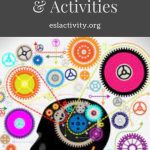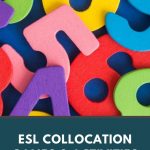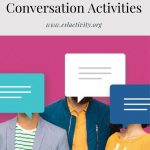If you’re looking for some of the best ESL reading activities, games, worksheets and lesson plans, then you’re certainly in the right place. Keep on reading for all the ESL reading comprehension activities you need to!

ESL reading games and activities
Let’s get into some top reading activities for ESL students to consider using in your classes.
ESL Reading Comprehension Activities and Games
Are you reading to get into the top ESL reading games and activities for kids, teenagers and adults? Without further ado, here are the best ESL reading activities to consider!
#1: Dialogue Substitution Reading Activity
Have you ever noticed that when students have to read a dialogue of some kind in the textbook, most of them just read it without really thinking about what they’re reading? It’s not really their fault, it’s just that we haven’t given them a reason to read carefully.
In order to turn a simple reading activity into one that focuses on grammar and meaning is to remove some of the words! Tricky, right? Try it out for yourself and you’ll notice how much more carefully students have to read. Learn more about it here:
Dialogue Substitution ESL Reading Comprehension Activity.
#2: Brochure Scanning ESL Reading Activity
Students are often quite good at reading for detail. However, the downfall is usually that it can take them forever to do this! This is often not like real life though in that students have to scan something quickly to find the information they need. For example, if they’re looking for a certain type of food on a menu, or the time of a certainly flight on a schedule.
An ESOL reading exercise that can help your students out with scanning is this one that uses a brochure of some kind like a travel brochure. Find out more details about it here:
Brochure Scanning Reading Activity.
#3: Concentration Reading and Memory Game
A fun way for students to work on their reading, along with memory skills and grammar or vocabulary is with concentration.
The way it works is that you make a bunch of cards that match in some way. They can be opposites like hot-cold, words with definitions or pictures, or present-past tense verbs (more ideas here: teach past tense). These are only a few examples—there are more options you may want to consider as well.
Then, in groups of 4, students place the cards face down on their desks in a random fashion. They take turns choosing two to see if they match. Find out more about it here:
ESL Concentration Memory Game.
#4: ESL Reading Lesson Plan Template
Are you a little bit unsure how to go about planning an ESL reading lesson? Don’t worry. Many teachers, even experienced ones aren’t that sure how to do it. But not to worry! You can follow these simple steps that include warm-up or lead-in, scanning, reading for detail, follow-up and more.
Check it out right here: ESL Reading Lesson Plan Template.
#5: Is that Sentence Correct?
- Amazon Kindle Edition
- Bolen, Jackie (Author)
- English (Publication Language)
- 59 Pages - 05/02/2017 (Publication Date)
A fun way for students to review grammar by reading is to try out this error correction activity. The way it works is that you can write a few sentences, some of which have errors while others do not.
Students have to read the sentences and then correct the errors. You can make this into a friendly competition by giving the first team to complete the activity correctly a small prize of some kind. If I do this variation, I usually tell students how many errors they should be looking for.
Learn more about it here: ESL Error Correction Game.
#6: Rock-Scissor-Paper
I love to use this game before a midterm or final exam to review material from the semester. The way it works is that you can write some questions and answers on a spreadsheet. Then, print them off and cut them out into separate strips of paper. Give each student a mix of question and answer papers (5-6).
Then, they have to go around the class to find their matches. Once they do, they can do rock-scissor-paper and the winner takes both papers and gets one point. The winner is the person with the most points at the end of the activity. Find out more here:
ESL Rock Scissor Paper Activity.
#7: ESL Surveys
I’m ALL about using surveys in my classes. They’re fun, engaging and cover a wide range of skills, including reading. The best part is that you can use them for just about any vocabulary set, grammar point or topic. They’re truly one of the most versatile ESL activities so try them out with your students today.
Do you want to learn more about how to make your own? All the details are right here: Surveys for ESL Students.
#8: English Reading Test Tips
Students are often trying to improve their reading skills in order to score better on English proficiency exams. If this is the case for your students, you’ll certainly want to check out these tips that’ll help improve scores, no matter what the best. And of course, teach them to your students.
You can find them all here: Reading Comprehension Test Tips.
#9: Odd One Out
If you’re looking for a quick ESL warmer that’s heavy on the reading, then consider trying out Odd One Out. The way it works is that you write groups of 4 words on the board. For example:
Apple orange carrot banana
Students have to say which one doesn’t match and then why. One possible answer for this one is carrot because it’s a vegetable, not a fruit.
Find out more about it here: Odd One Out ESL Warmer.
Teaching Reading Skills
If you want to learn more about teaching ESL reading skills, then check out this short video:
#10: Flyswatter Game
If you want to have some fun with your students, consider pulling out the flyswatters! The way it works is that you divide the students up into two teams and each team sends one student up to the front.
On the board, you’ll have a bunch of words related to a certain topic. Then, you can give some hints and the first student to slap the correct word with their flyswatter is the winner. There are also other variations and things you can use this game for besides vocabulary. Learn more about them here:
#11: Proofreading and Editing
A key part of English writing is reading closely to find errors. It’s not uncommon that English teachers fall into the trap of students writing and teachers correcting. Instead, opt for the better way of teaching students how to self-edit their own work with this simple activity:
#12: Mixed Up Sentences
If you want your students to get some practice with reading and sentences structure, then consider this quick activity. The way it works is that you can write a few sentences on the board but with mixed up word order. Students have to write them on a piece of paper in the correct order.
It’s simple, but works well as a quick warmer activity to review material from previous classes. Learn more about it here: ESL Mixed Up Sentences Activity.
#13: Problem/Advice Board Game
I love to play board games in real life which is why I like to bring them into my TEFL classroom as well. One area that they work extremely well for is problem and advice. The way it works is that students land on a square with a problem of some kind.
They have to read it, and then give some advice using the correct grammar. Find out more about it right here:
ESL Problem and Advice Board Game.
#14: Information Gap Activities
I love to use information gap activities. The way it works is that students work in pairs to complete a set of information, but each student only has half of the details. These kinds of activities are usually heavy on the reading, but also include a good dose of speaking. Check out our top picks here:
ESL Information Gap Activities.
- Amazon Kindle Edition
- Bolen, Jackie (Author)
- English (Publication Language)
- 211 Pages - 07/12/2020 (Publication Date)
#15: Story Timeline
If you get your students to read a story of some kind, then consider using this follow-up activity. The way it works is that students have to put some pieces of paper with the main sequence of events in the correct order. You can learn more about it right here:
Story Timeline Post-Reading Activity.
#16: Extensive Reading for English Learners
If you have access to a library or budget to buy some English novels, then consider doing some extensive reading in your classes. It can help your students with their reading skills as well as vocabulary acquisition in a big way. Find out more details about it right here:
Benefits of Extensive Reading.
#17: Running Dictation
#18: Ball Toss
A fun ESL reading game for young learners is ball toss. But, I’ve also used it with university students and adults and they found it fun too!
The way it works is that you write some words or phrases on a beach ball. Then, students toss it around the class and when someone catches it, they have to read what’s under their right thumb and then do something related to that. What they have to do depends on the level of the students. For all the possibilities, take a look at this article:
#19: Postcards
This is a fun, simple ESL writing activity that can easily be turned into a reading activity as well. When the students are done writing their postcard, post them around the class. Then, have students carefully read the information on the cards and make a quiz related to the details. It’s a nice reading activity ESL that you’ll want to try out!
Find out more about it: Postcards.
#20: ESL Fruit and Veggies Quiz
Try out this simple online quiz that requires students to read the clues before making a guess as to what fruit or vegetable it is.
#21: Error Correction Relay Race
I love to use this ESL reading activity with my students because it takes something old (error correction) and turns it into something new by making it into a game. It’s fun, engaging and students love it. Plus, it helps them work on their reading for detail skills too.
Find out more here: Error Correction Relay Race.
- Amazon Kindle Edition
- Bolen, Jackie (Author)
- English (Publication Language)
- 62 Pages - 01/21/2016 (Publication Date)
#22: Freeze Group Writing Activity
Although this is a writing activity, it’s also heavy on listening in that students have to read what other students have written before adding a line of their own. It’s fun, interactive and students generally love doing it!
Try it out for yourself: Freeze Group Writing Activity.
#23: Closest in Meaning
Try out this simple reading activity, Closest in Meaning that helps students infer details from the surrounding context if they don’t know some words. Students have to choose the sentence that is closest to the original one. It’s quick and easy and perfect for a warmer activity.
Have a look at it here: Closest in Meaning.
#24: English Phrases and Expressions Lesson Plan
A nice way to focus on English phrases, expressions and idioms is through a reading lesson plan like this one. Help students sound more like Native English speakers as they pick up some of these things that natives use all the time in speaking and writing.
Check it out: English Phrases Lesson Plan.
#25: Vocabulary Auction
#26: Short Stories for ESL Adults
One of my favourite ways to teach reading is with stories. The only issue is finding interesting and engaging ones that are at an appropriate level for English learners. That’s where a book like this one comes in. There are more than 20 ESL short stories about life in Canada.
Have a look: Short Stories for ESL Adults.
#27: More Ideas for TEFL Reading Lessons
#28: Post-Reading Activities for ESL
There are a million and one you things you can get your students to do in order to get the most mileage out of what they just read. Here are some of the best ideas:
#29: Prepositions of Place Game
Try out this reading and memory game with your students:
#30: Reading Treasure Hunt
Hide short reading passages or sentences around the classroom or outdoor area. Provide students with clues or prompts related to the content of the passages. Students work individually or in teams to find and read the hidden texts. This activity promotes reading comprehension and adds an element of adventure to the lesson.
#31: Story Chain
Begin with a short paragraph or sentence that sets the scene or introduces a character. Each student adds a sentence or paragraph to continue the story. They can pass the story to the next student or continue writing in a round-robin fashion. This collaborative activity encourages creativity, critical thinking, and reading fluency.
#32: Reader’s Theater
Select a short play or story and assign roles to students. They practice reading their parts with expression and then perform the play or story for their classmates. This activity improves reading fluency, comprehension, and public speaking skills.
#33: English Books for Beginners
If your students want some easier books to read, here are a few of the top recommendations for them:
ESL Reading Lesson Plans
Are you looking for some of the best lesson plans for teaching English reading comprehension? The good news is that you don’t have to make your own! Other teachers have gone before you and done the hard work. Here are some of my go-to sources:

ESL Reading Comprehension Exercises
ESL Reading Worksheets
As teachers, it can be super helpful to just print a worksheet and go! It can potentially save you a ton of time when planning lessons. Here are some of our top picks for ESL reading comprehension worksheets:
Did you Like these ELL Reading Activities?
- Amazon Kindle Edition
- Bolen, Jackie (Author)
- English (Publication Language)
- 187 Pages - 03/09/2016 (Publication Date)
Yes? Thought so. Then the book you’re going to love is this one over on Amazon: 101 ESL Activities for Teenagers and Adults. The key to better English classes is a wide variety of interesting and engaging activities and games and this book will help you get there in style!
The best part is that the book is well organized into sections: reading, speaking, review, icebreakers, etc. so you should be able to easily find what you need in just a minute or two. If that’s not some ESL teaching awesome, then I’m not sure what is.
You can get these ESL activities in both digital and print formats. Consider keeping a copy on the bookshelf in your office and using it as a handy reference guide. Or, taking the e-version with you to your favourite coffee shop for some lesson planning on the go.
It really is that easy to have better English classes! Head on over to Amazon to pick up a copy of the book for yourself:
Teaching ESL Reading FAQs
There are a number of common questions that people have about how to teach ESL reading. Here are the answers to some of the most common ones.
How do I teach ESL reading?
There are a number of strategies you can use to teach ESL reading that will help improve reading comprehension skills. They are as follows:
- Scanning
- Skimming
- Predicting
- Reading for detail
- Summarizing
- Taking notes
- Discussing
- Extracting
How do ESL students improve their reading skills?
ESL students can improve their reading skills in a number of ways.
- Use scanning and skimming techniques.
- Make predictions about the text.
- Look up unfamiliar words or grammatical patterns.
- Study vocabulary frequently.
- Extensive reading.
- Read a variety of different genres.
- Use reading comprehension questions.
- Read passages at your level, slightly above and also slightly below.
Why is reading difficult for ESL?
Reading is often difficult for ESL students because they lack a large enough vocabulary and have to stop too often to look up new words. However, extensive reading of texts at a slightly lower level can increase vocabulary, as can targeted study.
What is ESL reading?
ESL reading is when people who don’t speak English as their first language read a text. Abilities can range from reading single words to reading complicated, details academic texts.
What are the 7 strategies of reading?
To improve reading comprehension, teachers should introduce the 7 strategies of reading. They include:
- activating
- inferring
- monitoring/clarifying
- questioning
- searching/selecting
- summarizing
- visualizing/organizing
What is the aim of a reading lesson?
The aim of a reading lesson might be to expand a certain vocabulary set or to be introduced to a certain grammatical point. However, the aim may be more reading specific such as working on predicting when reading, note-taking, or reading for detail.
Tips for Teaching ESL Reading
Teaching reading comprehension to ESL learners can be a rewarding but challenging task. Here are some tips to help you effectively teach reading comprehension skills:
Pre-reading Activities
Before diving into the text, activate students’ prior knowledge on the topic. Engage them in pre-reading activities such as brainstorming, discussing related vocabulary, or predicting what the text might be about. This helps build curiosity and prepares students for what they are going to read.
Teach Reading Strategies
Introduce various reading strategies to your students. These strategies can include skimming (quickly scanning the text for general information), scanning (looking for specific details), and inferring (drawing conclusions based on context). Explicitly teach and model these strategies, and encourage students to apply them while reading.
Start with Shorter Texts
Begin with shorter texts that are at an appropriate reading level for your students. This allows them to build confidence and develop comprehension skills gradually. As they become more proficient, gradually introduce longer and more complex texts.
Vocabulary Development
Reading comprehension is closely tied to vocabulary knowledge. Teach and review vocabulary related to the topic or theme of the reading. Encourage students to use context clues to determine the meanings of unfamiliar words. Provide opportunities for vocabulary practice through activities like word matching, creating word webs, or using the words in sentences.
Scaffold Reading Tasks
Provide support for your students as they engage with the text. Use graphic organizers, such as KWL charts (What I Know, What I Want to Know, What I Learned), story maps, or concept maps, to help students organize their thoughts and make connections. Break down complex sentences or paragraphs, and encourage students to summarize key points or main ideas.
Comprehension Questions
Ask a variety of comprehension questions to assess students’ understanding of the text. These questions can include factual, inferential, and critical-thinking questions. Encourage students to support their answers with evidence from the text. Gradually increase the complexity of the questions as students progress in their reading abilities.
Provide Authentic Reading Materials
Supplement textbook readings with authentic materials, such as news articles, short stories, or blogs. Authentic materials expose students to real-world language use and enhance their cultural understanding. Choose texts that align with students’ interests and backgrounds to foster engagement.
Promote Discussion
After reading, facilitate discussions to encourage students to express their thoughts, share opinions, and ask questions about the text. This helps develop critical thinking and encourages students to delve deeper into the content. Pair students up for peer discussions or conduct whole-class discussions to promote interaction and collaboration.
Monitor Progress
Regularly assess students’ reading comprehension skills through quizzes, informal assessments, or reading logs. Track their progress and provide feedback to address areas for improvement. Celebrate their successes and offer encouragement throughout the learning process.
Cultivate a Love for Reading
Foster a positive reading environment by sharing your enthusiasm for reading. Recommend books, encourage independent reading, and create opportunities for students to explore different genres and authors. Instilling a love for reading can motivate students to become better readers and improve their overall reading comprehension.
Have your say about these Reading Activities for ESL Students
What are your thoughts about these reading comprehension activities for English learners? Did you try out one of them from this list or do you have another that you’d like to recommend? Leave a comment below and let us know what you think. We’d love to hear from you. Also, check out this TOEFL reading practice exercise.
Also be sure to give this article a share on Facebook, Pinterest, or Twitter. It’ll help other busy English teachers, like yourself find this useful resource.
Last update on 2022-07-17 / Affiliate links / Images from Amazon Product Advertising API









